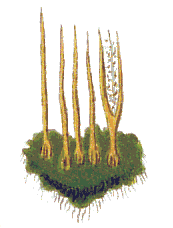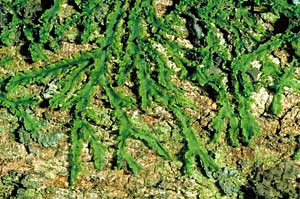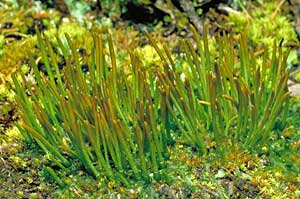
The bryophyte groups
What is a hornwort?
A hornwort is a flowerless, spore-producing plant - with the spores typically produced in a tapering, horn-like or needle-like capsule which develops from a flattish, green sheet ![]() . The introductory WHAT IS A BRYOPHYTE? page noted that bryophytes have a gametophyte stage and a sporophyte stage. In hornworts the gametophyte consists of the flattish, green sheet and is also called the thallus. The male and female gametes (sperm and eggs) are produced on the thallus (in antheridia and archegonia, respectively) and a fertilized egg will develop into a sporophyte - that tapering horn-like or needle-like structure mentioned above. Thus spores are part of the sexual reproduction cycle. There's more about this in the REPRODUCTION SECTION.
. The introductory WHAT IS A BRYOPHYTE? page noted that bryophytes have a gametophyte stage and a sporophyte stage. In hornworts the gametophyte consists of the flattish, green sheet and is also called the thallus. The male and female gametes (sperm and eggs) are produced on the thallus (in antheridia and archegonia, respectively) and a fertilized egg will develop into a sporophyte - that tapering horn-like or needle-like structure mentioned above. Thus spores are part of the sexual reproduction cycle. There's more about this in the REPRODUCTION SECTION.
The aim of this page is simply to describe the features you can see in a hornwort - in both the gametophyte and sporophyte stages.
The WHAT IS A MOSS? and WHAT IS A LIVERWORT? pages gave references to further photographs of Australian mosses and liverworts, published in field guides to Australian bryophytes. Hornworts are, unfortunately, virtually absent from such field guides![]() .
.
The following references are very useful for more detail about hornwort diversity and structure, from the macroscopic view to the microscopic level. Much of the information on this page has come from these books![]() .
.
What's in a name?The English word "wort" means "small plant" and it turns up in names such as Pennywort and Bladderwort. Thus a hornwort is a "small, horned plant". |
You might sometimes confuse hornworts with thallose liverworts (which also have flattish, sheet-like gametophytes). However, once you’ve read this page as well as the WHAT IS A LIVERWORT? page, you will have all the information to let you tell the two apart. For convenience, the distinguishing features of all the bryophytes are summarised on the page that lets you answer the question: WHICH BRYOPHYTE IS IT?
The hornworts constitute a small group. There are six generally accepted genera: Anthoceros, Dendroceros, Folioceros, Megaceros, Notothylas and Phaeoceros. There are over 300 published species names but it is thought that there are probably only 100-150 species. However, there's still considerable debate about the number of species, with more work needed to answer that question. Incidentally, the element -ceros that appears in most of the generic names is derived from the Greek word keros - which means "horn".
Amongst the hornworts the genus Notothylas is something of an oddity. As you will see below, it forms the exception to some of the statements that could otherwise be made of hornworts in general.
The hornwort gametophyte
As noted above, the hornwort gametophyte is an often lobed or wrinkled, greenish sheet (or thallus). It may be strap-like (and branched) or grow as a rosette, depending on the genus. The thallus is typically dark green (though light green to yellowish in Notothylas) and is typically many cells thick, though the genus Dendroceros is an exception. In that genus the thallus is strap-like (and branching) and each strap has a thick, central midrib with thin lateral wings, which are often wavy or ruffled. There's more about thallus growth in the LIFE CYCLE section. The thallus is attached to the substrate by smooth rhizoids, which are anchoring structures that are superficially root-like but without the absorptive functions of true roots. Rhizoids grow out from the underside of the thallus.
In a hornwort thallus there are from one to a few chloroplasts per cell, most commonly just one, large chloroplast per cell (though there may be up to 12 per cell in the genus Megaceros). Within photosynthesizing plants, chloroplasts are the sub-cellular structures that contain chlorophyll. In mosses and liverworts there are numerous chloroplasts per cell.
Growing tips are covered by mucilage which is produced by the surface cells. Hornworts don't have the slime papillae that are found in many liverworts, but appear to be able to produce mucilage in almost any cell. Within the thallus there are mucilage-containing cavities, formed by the breakdown of many cells into mucilage. As the thallus ages some of these mucilage cavities may dry out, resulting in air-filled cavities. The mucilage cavities are connected to the exterior via openings called slime-pores or mucilage clefts. The slime-pores are on the thallus underside and through them Nostoc (a cyanobacterium) can enter the mucilage cavities. Once inside a mucilage cavity the Nostoc multiplies and forms a symbiotic association with the hornwort. Nostoc provides the hornwort with nitrogen and gets carbohydrates in exchange. All hornworts have these Nostoc cavities ![]() . They are best developed in the genus Dendroceros, where they are readily visible to the naked eye as blackish dots. In other cases you may need a handlens to be able to see them for certain. Within a Nostoc cavity, outgrowths from the hornwort thallus penetrate the cyanobacterial colony.
. They are best developed in the genus Dendroceros, where they are readily visible to the naked eye as blackish dots. In other cases you may need a handlens to be able to see them for certain. Within a Nostoc cavity, outgrowths from the hornwort thallus penetrate the cyanobacterial colony.
There is little or no differentiation within a hornwort thallus. That is quite different to the case in the thalli of the COMPLEX THALLOSE LIVERWORTS, where the cells in different layers within the thallus have different functions. Hornworts also lack the scales that are present on the undersides of the thalli of complex thallose liverworts.
The hornwort sporophyte
A single thallus produces many sporophytes and a hornwort sporophyte is typically an erect, elongated, tapering, horn-like or needle-like structure. It is often several centimetres long (occasionally over 10 cm in length), though in the genus Notothylas the sporophytes are always small, often less than five millimetres long. So, rather than horn-like or needle-like, a Notothylas sporophyte is short and stubby - often slightly arched and so somewhat banana-like in shape. Also, the Notothylas sporophytes are not erect but are roughly parallel with the thallus or angled upward a little. Regardless of the shape, the entire structure is a spore capsule. There is no capsule-on-a-stalk sporophyte that you find so commonly with mosses and liverworts.
The sporophyte (except for the genus Notothylas) is constantly growing from a point just above its base. As new cells are added there, the existing sporophyte is naturally pushed out a bit. In theory this process of cell addition and sporophyte growth could continue indefinitely. In practice it does come to an end when conditions become too poor for the gametophyte. For example, if it becomes too dry, or the gametophyte is overgrown. Though the sporophyte contains chlorophyll and does photosynthesize, it still depends heavily on the gametophyte for carbohydrates. If the gametophyte suffers, sporophyte growth may stop.
Given the manner of sporophyte growth it's clear that the youngest cells are near the base and the oldest are at the top. The spores mature within the growing sporophyte and the first to mature will of course be those at the top. The spores a little lower down will mature a little later, those further down will mature later still and so on. Amongst the mature spores you will also find pseudo-elaters. These are tiny, filamentous structures that superficially resemble the spiralled ELATERS that are a feature of the capsules in many liverwort species. In the photo (right) the sporophytes are brown in the upper areas and green below. The green areas are those where spores have not yet reached maturity. None of the sporophytes in that photo have yet opened but here ![]() you can see a number of open sporophytes. A sporophyte splits along its length (from the top down) to release the spores over an extended period and a sporophyte will often split along two lines. Those lines run the length of the capsule and are opposite one another. The splitting starts at the top of the capsule and moves down, keeping pace with the maturing spores. This process splits the sporophyte into halves - but with the two halves usually remaining joined at the very top. In that case we get two slits, on opposite sides of the sporophyte, that lengthen over time. Equally often the sporophyte splits along one side only, so creating an expanding slit along just one side of the capsule. You will see that in Dendroceros and Megaceros sporophytes. As you might expect by now, the genus Notothylas is an exception to the general rule about the capsule splitting in two. Notothylas sporophytes may split in this way, but may also rupture irregularly or the capsule walls may simply decay. There's some more information in the SPOROPHYTE DEVELOPMENT SECTION.
you can see a number of open sporophytes. A sporophyte splits along its length (from the top down) to release the spores over an extended period and a sporophyte will often split along two lines. Those lines run the length of the capsule and are opposite one another. The splitting starts at the top of the capsule and moves down, keeping pace with the maturing spores. This process splits the sporophyte into halves - but with the two halves usually remaining joined at the very top. In that case we get two slits, on opposite sides of the sporophyte, that lengthen over time. Equally often the sporophyte splits along one side only, so creating an expanding slit along just one side of the capsule. You will see that in Dendroceros and Megaceros sporophytes. As you might expect by now, the genus Notothylas is an exception to the general rule about the capsule splitting in two. Notothylas sporophytes may split in this way, but may also rupture irregularly or the capsule walls may simply decay. There's some more information in the SPOROPHYTE DEVELOPMENT SECTION.
![An Australian Government Initiative [logo]](/images/austgovt_brown_90px.gif)



